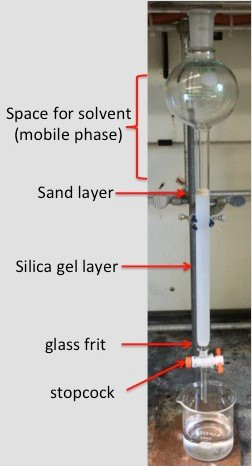Cromatografia em coluna
Visão Geral
Fonte: Laboratório do Dr. Jimmy Franco - Merrimack College
A cromatografia da coluna é uma das técnicas mais úteis para purificar compostos. Esta técnica utiliza uma fase estacionária, que é embalada em uma coluna, e uma fase móvel que passa pela coluna. Esta técnica explora as diferenças de polaridade entre os compostos, permitindo que as moléculas sejam separadas de forma fácil. 1 As duas fases estacionárias mais comuns para cromatografia de coluna são gel de sílica (SiO2) e alumina (Al2O3),sendo as fases móveis mais utilizadas como solventes orgânicos. 2 Os solventes escolhidos para a fase móvel dependem da polaridade das moléculas serem purificadas. Tipicamente, compostos mais polares requerem mais solventes polares, a fim de facilitar a passagem das moléculas através da fase estacionária. Uma vez concluído o processo de purificação, o solvente pode ser removido das frações coletadas usando um evaporador rotativo para produzir o material isolado.
Procedimento
1. Chorume de Gel de Sílica
- Despeje o gel de sílica em um frasco de Erlenmeyer. O peso do material de embalagem deve ser aproximadamente 50x o da amostra que está sendo separada. Se os compostos separados tiverem valores Rf muito semelhantes, então pode exigir o uso de uma quantidade maior de sílica por amostra, o que é o caso neste exemplo.
- Coloque 10 g de sílica no frasco de Erlenmeyer, uma vez que 50 mg de amostra (45 mg de fluorenona e 5 mg de tetrafenilaporfirina) estão sendo i
Resultados
A amostra contendo uma mistura de tetrafenilaporfirina (TPP, 5 mg) e fluorenona (45 mg) foi separada com sucesso e cada composto foi isolado. O TPP eluiliu primeiro da coluna como uma faixa roxa-avermelhada escura e a fluorenona posteriormente eluiçada da coluna como uma faixa amarela (Figura2). As frações elucidas foram coletadas em tubos de ensaio e identificadas por suas cores distintas(Figura 3). As frações contendo os compostos ...
Aplicação e Resumo
Resumo
A cromatografia da coluna é um método conveniente e versátil para purificar compostos. Este método separa compostos baseados na polaridade. Explorando diferenças na polaridade das moléculas, a cromatografia da coluna pode separar facilely os compostos pela taxa em que os compostos atravessam a fase estacionária da coluna. Um dos benefícios da cromatografia da coluna (especialmente quando comparada à recristalização) é que muito pouco sobre os compostos prec...
Referências
- Mayo, D. W.; Pike, R. M.; Forbes, D. C., Microscale organic laboratory : with multistep and multiscale syntheses. 5th ed.; J. Wiley & Sons: Hoboken, NJ; p xxi, 681 p (2011).
- Armarego, W. L. F.; Chai, C. L. L., Purification of laboratory chemicals. 5th ed.; Butterworth-Heinemann: Amsterdam; Boston; p xv, 609 p (2003).
- Silverman, R. B.; Holladay, M. W., The organic chemistry of drug design and drug action. Third edition / ed.; Elsevier/AP, Academic Press, is an imprint of Elsevier: Amsterdam ; Boston; p xviii, 517 pages (2014).
- Mortensen, D. S.; Perrin-Ninkovic, S. M.; Shevlin, G.; Elsner, J.; Zhao, J.; Whitefield, B. et. al. Optimization of a Series of Triazole Containing Mammalian Target of Rapamycin (mTOR) Kinase Inhibitors and the Discovery of CC-115. Journal of Medicinal Chemistry (2015).
- Davies, D. R.; Johnson, T. M., Isolation of Three Components from Spearmint Oil: An Exercise in Column and Thin-Layer Chromatography. Journal of Chemical Education,84 (2), 318 (2007).
- Taber, D. F.; Hoerrner, R. S., Column chromatography: Isolation of caffeine. Journal of Chemical Education, 68 (1), 73 (1991).
Tags
Pular para...
Vídeos desta coleção:

Now Playing
Cromatografia em coluna
Organic Chemistry
360.8K Visualizações

Introdução à Catálise
Organic Chemistry
34.6K Visualizações

Montagem de um sistema de refluxo para reações químicas aquecidas
Organic Chemistry
168.3K Visualizações

Condução de reações abaixo da temperatura ambiente
Organic Chemistry
70.7K Visualizações

Transferência de Solventes usando Linhas Schlenk
Organic Chemistry
41.7K Visualizações

Desgaseificação de Líquidos com Ciclagem de Congelamento-Bombeamento-Descongelamento
Organic Chemistry
56.3K Visualizações

Preparação de Reagentes e Equipamentos Anidros
Organic Chemistry
79.4K Visualizações

Purificação de Compostos por Recristalização
Organic Chemistry
709.9K Visualizações

Separação de Misturas por Precipitação
Organic Chemistry
158.0K Visualizações

Extração sólido-líquido
Organic Chemistry
238.0K Visualizações

Evaporação rotativa para remover solvente
Organic Chemistry
212.9K Visualizações

Destilação Fracionária
Organic Chemistry
334.7K Visualizações

Crescimento de Cristais para Análise de Difração de Raios-X
Organic Chemistry
32.9K Visualizações

Realização de Cromatografia de Camada Fina 1D
Organic Chemistry
290.1K Visualizações

Espectroscopia de ressonância magnética nuclear (NMR)
Organic Chemistry
248.9K Visualizações
Copyright © 2025 MyJoVE Corporation. Todos os direitos reservados
